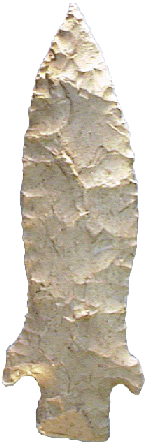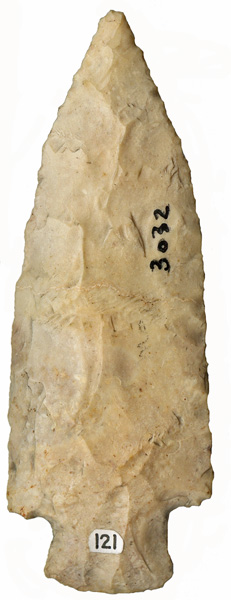



Point Type: ETLEY
Also See: Eva,
Darl,
Hardin, Lang, Meadowood, Morton Lanceolate, Pickwick, Red Ocher, Smith Basal Notched, Spring Creek, Stilwell, Stone Square Stemmed
Location: Midwestern United States
Associated Dates:
4000 - 2500 B.P. - Late Archaic to Early Woodland
Morphology: Corner
Notched - Basal
Notched
General Description: The Etley type is a large
sized narrow blade or spearpoint with a long needle-like distal tip
and a long blade with recurvate blade edges. However in some specimens, the
recurved outline of
the blade is not pronounced. The Etley has a short expanding stem (however there are contracting
stemmed variants) with a straight to slightly convex basal edge. The stem is usually about 1/10th the total length
of the point. The Etley exhibits a distinct and pronounced barbed shoulder that usually expands and the barbs have a tendency
to point downwards and away from the blade towards the base. The
barbs are usually rounded somewhat. The blade edge just above the
barbs is usually incurvate until about one-half of the length of the point and
then arcs in an excurvate manner to the tip. The maximum overall width
usually occurs at the tip of the barbs. Flake scars are flat,
expanding and massive. The blade cross section can vary from
parallel-sided to triangular. Reworking due to use wear does affect the barbs which can vary from
expanding to absent on highly reworked specimens.
The Etley point type contains specimens of imposing
size and technical knapping excellence.
The Etley is found chiefly in the St. Louis, Missouri area including central and southern Illinois and east-central Missouri. The Etley could occur in lower frequency in the lower Ohio River Valley and a single blade was found in a burial at the Crib Mound site in Spencer County, Indiana. The Etley is found on the surface, in refuse pits and in mortuary caches with extended burials. Most are made from local white cherts and a few from Missouri are made from a black chert. The Etley may be related to the Pickwick type which is from the same time period.
The Etley
ranges in size from 76 mm to 279 mm in length. The width varies from 32 mm to 60
mm. The stem width ranges from 19 mm to 26 mm. Typical overall thickness is 10
mm to 15 mm. The barbs run from 6 mm to 10 mm in length on most specimens.
The Etley type was named "Etley
Stemmed" by Edward G. Scully in 1951 for examples found at
the Oettle Farm, Calhoun County, Illinois and was anglicized to
the "Etley" by Dr. P. F. Titterington.
About the Point Above (Left): The Etley blade pictured at the top left hand side of this page, is an average sized for the type class and is made from white Burlington chert that has high occurrences of mineralization patination. The blade measures 160 mm in length and measures 55 mm at its widest point which is across the barbs. The maximum blade thickness is 10.5 mm. The stem is 21 mm long and is 26 mm wide at the base which is slightly ground. The point was formerly in the Norris Garriott collection and is from Warren County, Missouri. Catalog Number 111-166-R
About the Point Above (Left): The Etley blade pictured at the top right hand side of this page, is an average sized for the type class and is made from white Burlington chert that has high occurrences of mineralization patination along with a older catalog number ("3032") written in india ink. This specimen does not have barbs and examination shows some edge wear and bifacial retouch for resharpening purposes. The blade measures 106 mm in length and measures 36 mm at its widest point which is across the shoulders. The maximum blade thickness is 10.6 mm. The stem is 16.3 mm long and is 23 mm wide at the base which is slightly ground. The stem thickness is 6.3 mm. The point was formerly in the Ralph Whitehead collection of Boston, Mass. and was found in Warren County, Missouri according to Whitehead's catalog card. Catalog Number 121-180-O
References: Baker, Bell (2), Dragoo (c, e), Hranicky (1), Justice (1), Overstreet, Perino (1)
© Copyright 1997 - 2009 LITHICS-Net WWW.LITHICSNET.COM
Use Your Browser's BACK Button to Return to the LITHICS-Net Index.